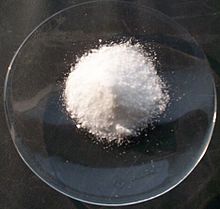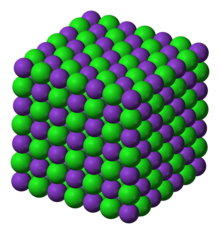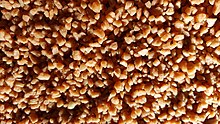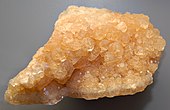Potassium chloride

| |

| |
| Names | |
|---|---|
Other names
| |
| Identifiers | |
3D model (
JSmol ) |
|
| ChEBI | |
| ChEMBL | |
| ChemSpider | |
| DrugBank | |
ECHA InfoCard
|
100.028.374 |
| E number | E508 (acidity regulators, ...) |
| KEGG | |
PubChem CID
|
|
RTECS number
|
|
| UNII | |
CompTox Dashboard (EPA)
|
|
| |
| |
| Properties | |
| KCl | |
| Molar mass | 74.555 g·mol−1 |
| Appearance | white crystalline solid |
| Odor | odorless |
| Density | 1.984 g/cm3 |
| Melting point | 770 °C (1,420 °F; 1,040 K) |
| Boiling point | 1,420 °C (2,590 °F; 1,690 K) |
| 27.77 g/100mL (0 °C) 33.97 g/100mL (20 °C) 54.02 g/100mL (100 °C) | |
| Solubility | Soluble in glycerol, alkalies Slightly soluble in alcohol Insoluble in ether[1] |
| Solubility in ethanol | 0.288 g/L (25 °C)[2] |
| Acidity (pKa) | ~7 |
| −39.0·10−6 cm3/mol | |
Refractive index (nD)
|
1.4902 (589 nm) |
| Structure | |
| face centered cubic | |
| Fm3m, No. 225 | |
a = 629.2 pm[3]
| |
| Octahedral (K+) Octahedral (Cl−) | |
| Thermochemistry | |
Std molar
entropy (S⦵298) |
83 J·mol−1·K−1[4] |
Std enthalpy of (ΔfH⦵298)formation |
−436 kJ·mol−1[4] |
| Pharmacology | |
| A12BA01 (WHO) B05XA01 (WHO) | |
| Oral, IV, IM | |
| Pharmacokinetics: | |
| Kidney: 90%; Fecal: 10%[5] | |
| Hazards | |
| NFPA 704 (fire diamond) | |
| Flash point | Non-flammable |
| Lethal dose or concentration (LD, LC): | |
LD50 (median dose)
|
2600 mg/kg (oral, rat)[6] |
| Safety data sheet (SDS) | ICSC 1450 |
| Related compounds | |
Other anions
|
Potassium fluoride Potassium bromide Potassium iodide |
Other cations
|
Lithium chloride Sodium chloride Rubidium chloride Caesium chloride Ammonium chloride |
Related compounds
|
Potassium hypochlorite Potassium chlorite Potassium chlorate Potassium perchlorate |
Except where otherwise noted, data are given for materials in their standard state (at 25 °C [77 °F], 100 kPa).
| |
Potassium chloride (KCl, or potassium salt) is a
It occurs naturally as the mineral sylvite, which is named after salt's historical designations sal degistivum Sylvii and sal febrifugum Sylvii,[9] and in combination with sodium chloride as sylvinite.[10]
Uses
Fertilizer
The majority of the potassium chloride produced is used for making fertilizer, called potash, since the growth of many plants is limited by potassium availability. Potassium chloride sold as fertilizer is known as muriate of potash. The vast majority of potash fertilizer worldwide is sold as muriate of potash.[citation needed]

Medical use
Potassium is vital in the
Culinary use
Potassium chloride can be used as a
Execution
In the United States, potassium chloride is used as the final drug in the three injection sequence of lethal injection as a form of capital punishment. It induces cardiac arrest, ultimately killing the inmate.[14]
Industrial
This section needs additional citations for verification. (September 2022) |
As a chemical
It is used as a supplement in animal feed to boost the potassium level in the feed. As an added benefit, it is known to increase milk production.
It is sometimes used in solution as a
Glass manufacturers use granular potash as a flux, lowering the temperature at which a mixture melts. Because potash imparts excellent clarity to glass, it is commonly used in eyeglasses, glassware, televisions, and computer monitors.
Because natural potassium contains a tiny amount of the isotope
Potassium chloride is used in some
Potassium chloride was once used as a
Along with
Potassium chloride is also an optical crystal with a wide transmission range from 210 nm to 20 µm. While cheap, KCl crystals are
Potassium chloride is used as a
Toxicity
The typical amounts of potassium chloride found in the diet appear to be generally safe.[15] In larger quantities, however, potassium chloride is toxic. The LD50 of orally ingested potassium chloride is approximately 2.5 g/kg, or 190 grams (6.7 oz) for a body mass of 75 kilograms (165 lb). In comparison, the LD50 of sodium chloride (table salt) is 3.75 g/kg.
Intravenously, the LD50 of potassium chloride is far smaller, at about 57.2 mg/kg to 66.7 mg/kg; this is found by dividing the lethal concentration of positive potassium ions (about 30 to 35 mg/kg)[16] by the proportion by mass of potassium ions in potassium chloride (about 0.52445 mg K+/mg KCl).[17]
Chemical properties
Solubility
KCl is soluble in a variety of polar solvents.
| Solvent | Solubility (g/kg of solvent at 25 °C) |
|---|---|
Water |
360 |
| Liquid ammonia | 0.4 |
| Liquid sulfur dioxide | 0.41 |
| Methanol | 5.3 |
| Ethanol | 0.37 |
| Formic acid | 192 |
| Sulfolane | 0.04 |
| Acetonitrile | 0.024 |
| Acetone | 0.00091 |
| Formamide | 62 |
| Acetamide | 24.5 |
| Dimethylformamide | 0.17–0.5 |
Solutions of KCl are common standards, for example for
Redox and the conversion to potassium metal
Although potassium is more
This method is the main method for producing metallic potassium. Electrolysis (used for sodium) fails because of the high solubility of potassium in molten KCl.[10]
Other potassium chloride stoichiometries
Potassium chlorides with formulas other than KCl have been predicted to become stable under pressures of 20 GPa or more.[19] Among these, two phases of KCl3 were synthesized and characterized. At 20-40 GPa, a trigonal structure containing K+ and Cl3− is obtained; above 40 GPa this gives way to a phase isostructural with the intermetallic compound Cr3Si.
Physical properties
Under ambient conditions the crystal structure of potassium chloride is like that of NaCl. It adopts a face-centered cubic structure known as the B1 phase with a lattice constant of roughly 6.3 Å. Crystals cleave easily in three directions. Other polymorphic and hydrated phases are adopted at high pressures.[20]
Some other properties are
- Transmission range: 210 nm to 20 µm
- Transmittivity = 92% at 450 nm and rises linearly to 94% at 16 µm
- Refractive index = 1.456 at 10 µm
- Reflection loss = 6.8% at 10 µm (two surfaces)
- dN/dT (expansion coefficient)= −33.2×10−6/°C
- dL/dT (refractive index gradient)= 40×10−6/°C
- Thermal conductivity = 0.036 W/(cm·K)
- Damage threshold (Newman and Novak): 4 GW/cm2 or 2 J/cm2 (0.5 or 1 ns pulse rate); 4.2 J/cm2 (1.7 ns pulse rate Kovalev and Faizullov)
As with other compounds containing potassium, KCl in powdered form gives a lilac flame.
Production


Potassium chloride is extracted from minerals
The vast majority of potassium chloride is produced as agricultural and industrial grade potash in Saskatchewan, Canada, as well as Russia and Belarus. Saskatchewan alone accounted for over 25% of the world's potash production in 2017.[21]
Laboratory methods
Potassium chloride is inexpensively available and is rarely prepared intentionally in the laboratory. It can be generated by treating potassium hydroxide (or other potassium bases) with hydrochloric acid:
This conversion is an acid-base neutralization reaction. The resulting salt can then be purified by recrystallization. Another method would be to allow potassium to burn in the presence of chlorine gas, also a very exothermic reaction:
References
- ^ "Potassium chloride (PIM 430)". International Programme on Chemical Safety. 3.3.1 Properties of the substance. Retrieved 2011-01-17.
- ^ "periodic-table-of-elements.org". Archived from the original (website shows values in g/100ml) on 29 October 2020. Retrieved 4 October 2019.
- ISBN 978-3-540-42180-1.
- ^ ISBN 978-0-618-94690-7.
- ^ "Compound Summary for Potassium Chloride". PubChem. U.S. National Library of Medicine. CID 4873. Retrieved 17 October 2015.
- ^ Chambers M. "7447-40-7 - WCUXLLCKKVVCTQ-UHFFFAOYSA-M - Potassium chloride [USP:JAN]". ChemIDplus. U.S. National Library of Medicine. Archived from the original on 15 July 2015. Retrieved 22 December 2017.
- )
- ^ "Potassium Fertilizers (Penn State Agronomy Guide)". Penn State Agronomy Guide (Penn State Extension). Archived from the original on 2016-12-20. Retrieved 2016-12-10.
- ^ Watts, Henry (1883). A Dictionary of Chemistry and the Allied Branches of Other Sciences. Longmans, Green, and Company.
- ^ ISBN 978-3-527-30673-2.
- hdl:10665/325771. WHO/MVP/EMP/IAU/2019.06. License: CC BY-NC-SA 3.0 IGO.
- ISBN 978-1-85573-443-2.
... in dietary food containing potassium chloride, thaumatin added in the ratio of 1 ppm considerably reduces the sensation of bitterness. ...
- PMID 22901084.
- ^ "Overview of Lethal Injection Protocols". Death Penalty Information Center. Retrieved 2024-02-28.
- ^ Center for Food Safety and Applied Nutrition. "GRAS Substances (SCOGS) Database - Select Committee on GRAS Substances (SCOGS) Opinion: Potassium chloride". www.fda.gov. Archived from the original on 31 October 2017. Retrieved 21 July 2019.
- PMID 838413.
- ^ "Molecular weight of KCl". www.convertunits.com. Retrieved 2018-11-04.
- ISBN 978-0-85312-027-8.[page needed]
- PMID 27211847.
- PMID 36468558.
- ^ "Mineral Commodity Summaries" (PDF). U.S. Geological Survey. January 2018. Archived from the original (PDF) on 10 January 2019.
Further reading
- Lide DR, ed. (2005). CRC Handbook of Chemistry and Physics (86th ed.). Boca Raton (FL): CRC Press. ISBN 0-8493-0486-5.
- ISBN 978-0-08-022057-4.




